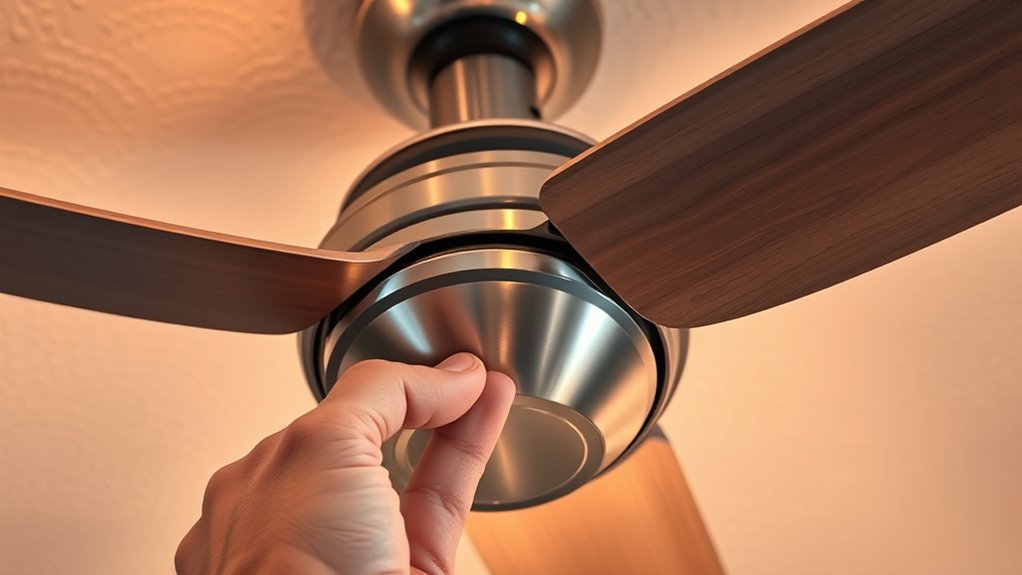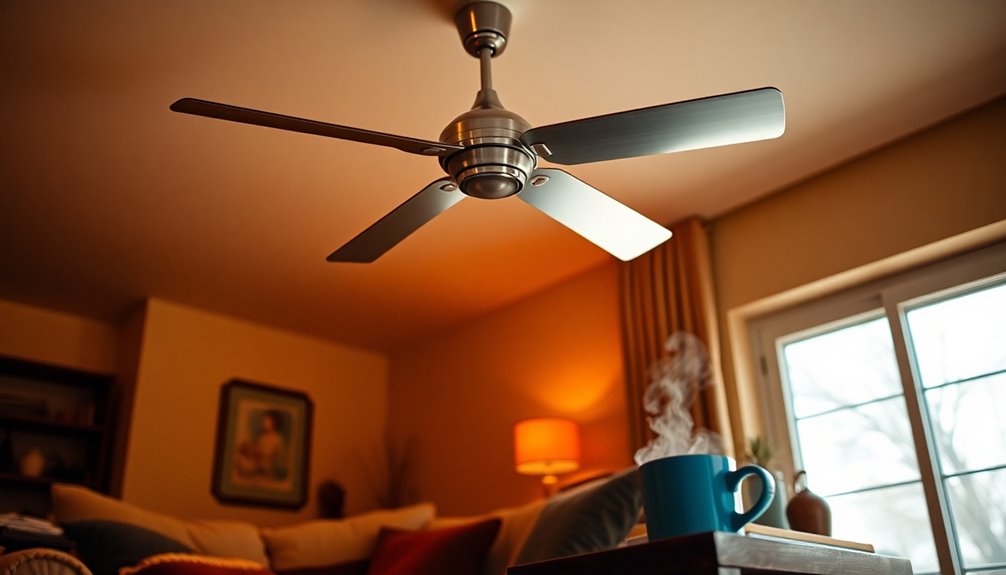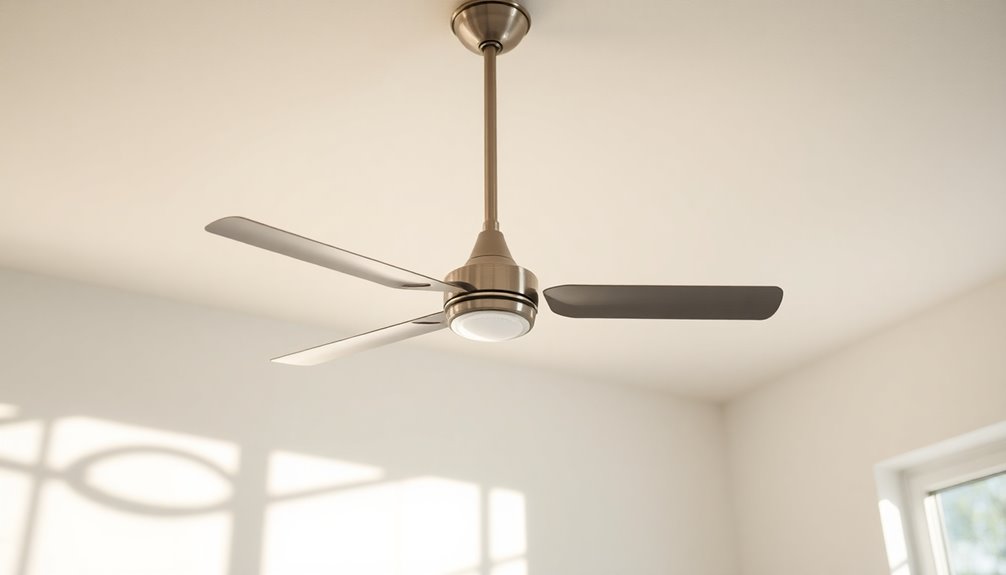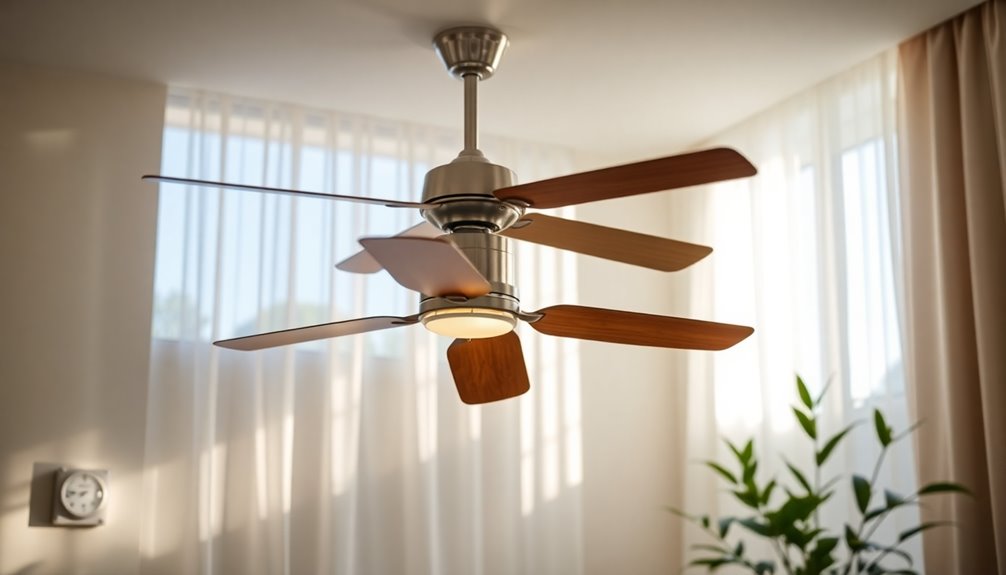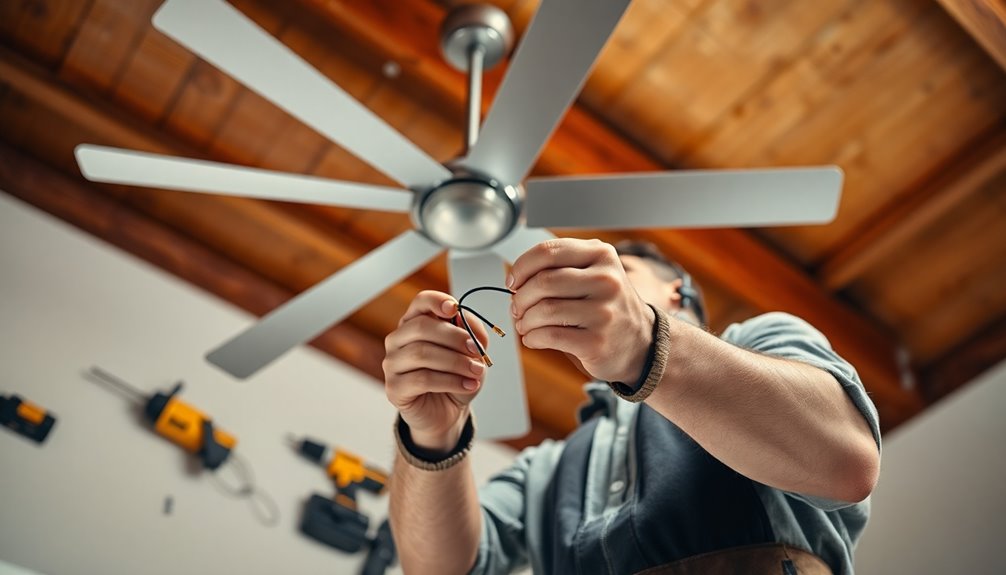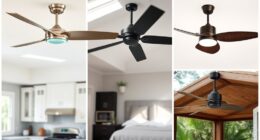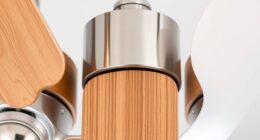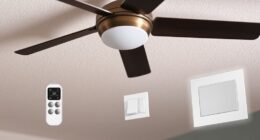If your ceiling fan wobbles, start by tightening all mounting screws and hardware to guarantee it’s securely attached. Next, inspect the blades for warping, damage, or uneven length, and clean them thoroughly to remove dust and debris. Use a fan balancing kit to identify imbalance points and attach weights as needed. Regular maintenance can solve most wobbling issues, and if you want to know more detailed fixes, keep exploring further tips.
Key Takeaways
- Ensure the fan is properly mounted on a secure, level electrical box to prevent wobbling.
- Check and tighten all blade screws, ensuring blades are identical and properly aligned.
- Use a balancing kit to identify wobbling blades and attach weights for quick stabilization.
- Clean blades and hardware regularly to remove dust and debris that cause imbalance.
- Verify that the fan is level and securely installed, tightening all support screws and canopy cover.
Verify Proper Ceiling Fan Installation

To prevent ceiling fan wobble, you need to verify that it’s installed correctly. Start with proper ceiling fan installation by ensuring the fan is mounted on a fan-rated electrical box securely attached to a ceiling cross beam or structural support. Check that the mounting bracket is firmly connected to the electrical box and that the canopy cover is securely fastened, preventing movement. Use a level tool during installation to confirm the fan is perfectly level, with no tilt or slant, which is essential for proper balance. Also, ensure the fan is attached with lag screws or mounting brackets designed specifically for ceiling fans, not just standard light fixtures. Proper installation sets the foundation for a stable, wobble-free ceiling fan. Additionally, verifying the installation quality can help identify potential issues that might cause wobbling or imbalance. Regularly inspecting fan blades for warping or damage can also prevent wobbling and improve stability. Taking these steps can significantly reduce the risk of ceiling fan imbalance over time. Furthermore, ensuring the fan blade alignment is correct can help maintain proper balance and reduce wobbling.
Tighten Loose Fasteners and Hardware
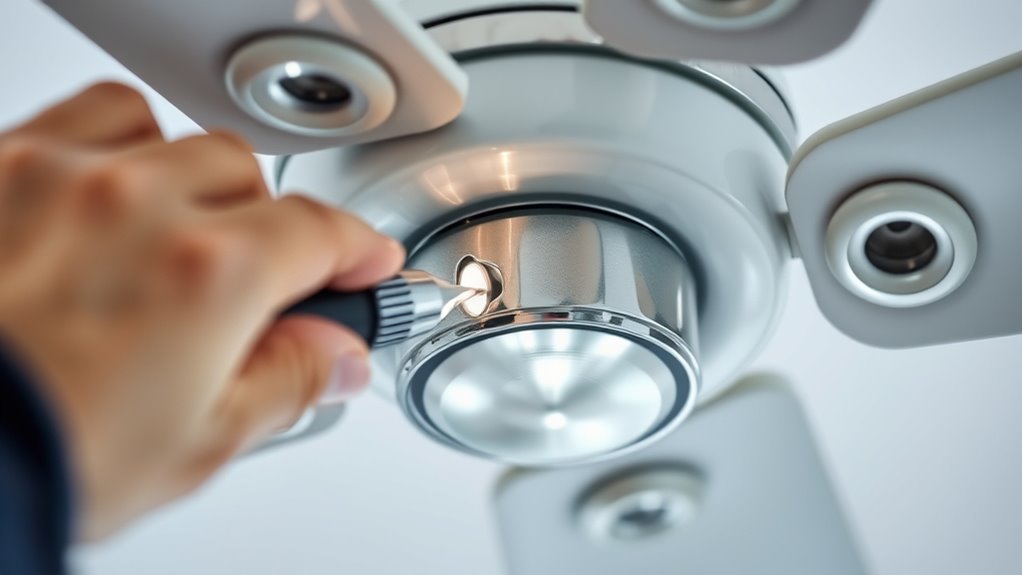
Regularly inspecting and tightening all screws and fasteners on your ceiling fan helps prevent wobbling. Loose fasteners on blades, mounting brackets, or light kits can cause instability and increase wear. Use a screwdriver or wrench to secure these fasteners, making sure they’re snug but not overtightened. Check the attachment points of the mounting bracket to the electrical box, as well as downrod support screws and canopy cover screws. Tightening these hardware components eliminates movement that leads to fan wobble. Regular hardware tightening ensures a stable, balanced fan and reduces the risk of damage. Keep an eye on the following areas: part stability, which impacts the overall stability and visual clarity during operation. Additionally, ensuring balanced blades can significantly reduce wobbling and prolong the fan’s lifespan, especially when combined with proper blade alignment. Regularly checking and maintaining these components helps maintain optimal fan performance and safety.
Inspect and Adjust Ceiling Fan Blades
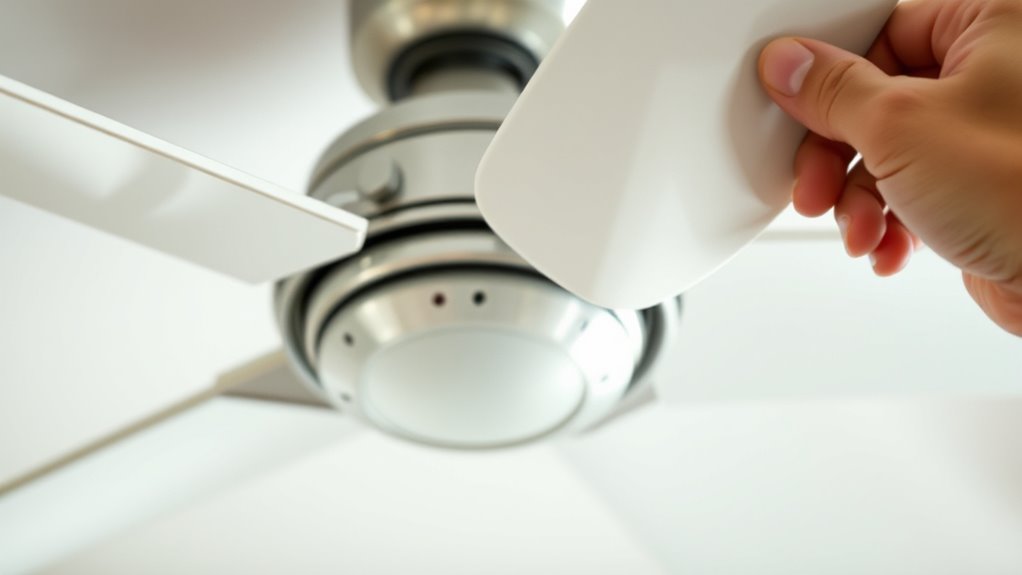
Have you checked whether your ceiling fan blades are properly aligned and secure? Start by measuring the distance from the ceiling to each blade tip to spot uneven blades. If some blades hang lower or higher, adjust them for proper alignment. Proper alignment helps prevent fan wobble and ensures smoother operation. Additionally, using a balancing kit can help fine-tune the fan’s stability and reduce wobbling. Tighten any loose mounting screws or brackets that secure the fan parts, ensuring stability. Inspect the blades for warping, cracks, or damage; replace any bent or warped blades to maintain balance. Also, ensure that the fan blade alignment is correct, as misaligned blades are a common cause of wobbling. Confirm all blades are identical in length, width, and weight—any differences can cause wobbling. Also, make sure the blade screws are securely fastened and evenly torqued. Properly aligning and securing your ceiling fan blades is essential to balance a ceiling fan and reduce wobble during operation.
Use a Fan Balancing Kit to Detect Imbalance
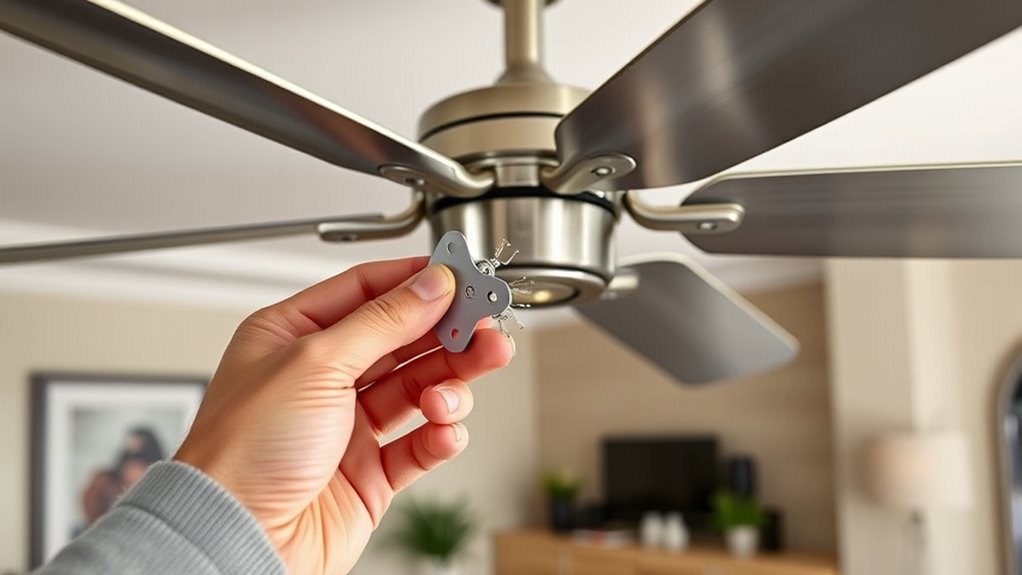
To detect if your ceiling fan is unbalanced, attach the plastic clip from the balancing kit to a suspect blade. Turn on the fan and see if wobbling improves when you move the clip along the blade’s length. Once you find the spot where wobbling is minimized, add a weight there to stabilize the fan. Proper maintenance can help ensure your fan operates smoothly and efficiently, preventing issues that could lead to long-term damage. Using a paint sprayer for repairs or modifications can also help apply balancing weights precisely and efficiently. Additionally, scheduling regular lifestyle maintenance checks can help identify and address issues early before they worsen. Regular inspection of your ceiling fan blades can further prevent imbalance and prolong the device’s lifespan.
Attach the Plastic Clip
Attaching the plastic clip is the first step in using a fan balancing kit to detect an imbalance. Start by securing the plastic clip onto the end of a fan blade, roughly halfway along its length. This clip acts as a marker to help identify where the blade’s weight distribution might be uneven. Using the clip as a weight distribution indicator, you can more accurately determine the optimal position for the balancing weight. Once in place, turn on your fan to high speed and observe if the wobble decreases with the clip positioned there. To pinpoint the exact spot that minimizes wobbling, slide the plastic clip along the edge of the blade toward the tip or near the mounting point. Test the fan after each movement, and note the position where the wobble lessens. This process guides you to place the correct balance weight on the blade for smoother operation. Understanding how local resources can support you in maintaining your fan can further improve your troubleshooting efforts. Additionally, being aware of proper maintenance techniques can prevent future wobbling issues and extend the lifespan of your fan. Utilizing powerful persuasive words in your maintenance instructions can also encourage consistent upkeep, reducing wobbling over time.
Test Blade Wobble
Start by attaching a plastic clip to the end of each fan blade, then turn your fan on high. Watch for which blade causes the most blade wobble, indicating an imbalance.
Move the plastic clip along the length of the suspect blade to find the position where the wobble reduces. This helps you identify the specific area of imbalance.
Use a fan balancing kit with adjusting weights to counteract the wobble. Place the weights along the blade at the ideal position you discovered during testing.
After each adjustment, run the fan again to check if the wobble decreases. Repeating this process ensures you locate the problematic blade and the precise spot needing correction, leading to a more stable and smoother-running ceiling fan.
Fine-Tune With Weights
Using a fan balancing kit, you can fine-tune your ceiling fan by detecting and correcting imbalances with weights. Attach the plastic clip from the kit to a blade’s midpoint and run the fan on high. Observe if the wobble improves or worsens. Move the clip along the blade toward the tip in small steps, retesting after each move to find the best position. When the wobble lessens, place a balancing weight in line with the clip at that spot on the blade. Remove the clip, secure the weight, and run the fan again to confirm stability. This process helps you identify the precise location of imbalance using a ceiling fan balancing kit, ensuring your fan spins smoothly without wobbling.
| Step | Action |
|---|---|
| Attach clip | Place clip on the blade’s midpoint |
| Test wobble | Run fan, observe wobble changes |
| Apply weights | Add balancing weight at optimal spot |
Apply Balance Weights for Stability
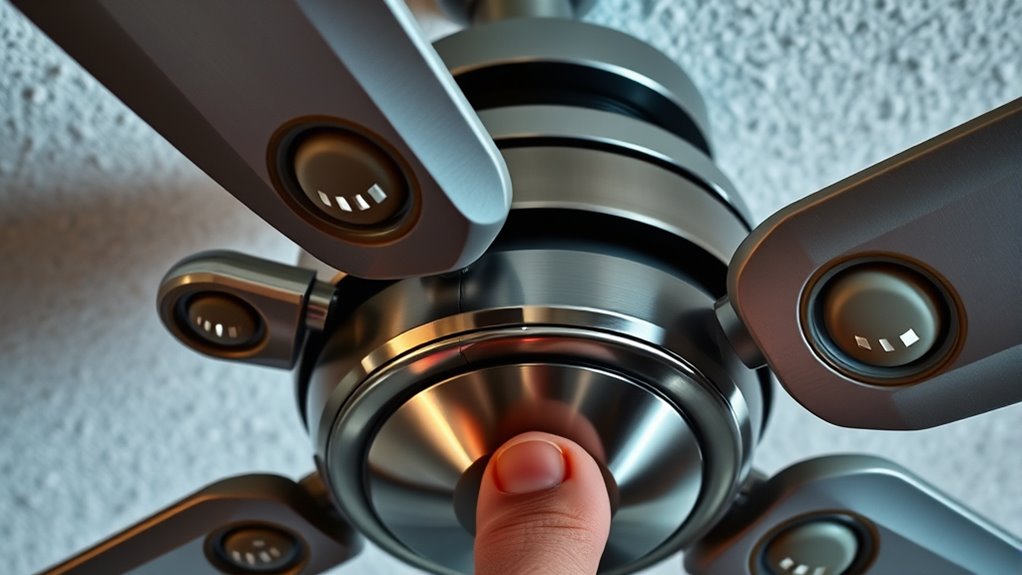
Once you’ve identified the best position for the weight, make sure to place the balance weight directly in line with the clip on the affected blade.
Secure the weight firmly to prevent it from coming loose during operation.
After attaching, run the fan at high speed to verify that the wobble has been minimized.
Correct Weight Placement
To effectively reduce wobbling, you should apply balance weights directly in line with the plastic clip on the wobbling blade. Proper weight placement ensures the blade remains balanced, minimizing wobble and noise.
Once the weight is positioned, remove the plastic clip to prevent it from falling off during operation. If needed, use multiple weights, placing them strategically along the blade for optimal stability.
Make sure the weights are firmly adhered and aligned with the blade’s center to maximize effectiveness. After placement, re-test the fan on high speed to verify the wobble has decreased or disappeared.
Correct weight placement is essential for a smooth, balanced fan operation, saving you from ongoing wobble issues and potential damage. Consistent testing confirms your adjustments work.
Secure the Weights
Securing the balance weights properly is crucial for stabilizing your ceiling fan. After placing the weights on the wobbling blade, make sure they’re firmly attached along the line with the plastic clip. Remove the plastic clip once the weight is in place to guarantee it stays secured during operation.
Use multiple weights if needed, distributing them evenly to achieve better balance and reduce wobble. Double-check that all weights are tightly attached before running the fan at high speed to prevent them from falling off.
Properly secured weights will help maintain a smooth, stable rotation. After securing the weights, reassess the fan’s wobble and make any necessary adjustments.
This process ensures your fan runs quietly and safely, minimizing wobbling issues.
Clean Dust and Debris From Fan Components
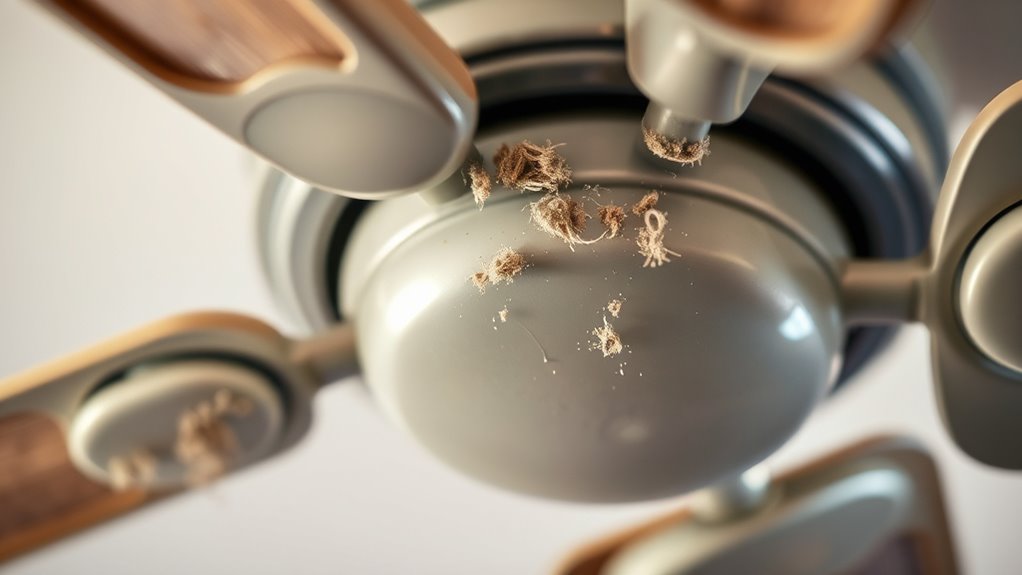
Dust and debris buildup on fan blades, motor hubs, and mounting hardware can cause imbalance and wobbling, so regular cleaning is vital. To maintain proper function, you should focus on cleaning blades, removing dust from hidden areas, and checking for any dirt that might add weight unevenly.
Regularly clean fan blades and hardware to prevent imbalance and wobbling.
Here are some tips to help:
- Use a damp cloth to clean blades thoroughly
- Employ compressed air or a soft brush for hard-to-reach spots
- Ensure all blades are dry before testing for wobble
- Check motor hubs and mounting hardware for dust accumulation
- Remove built-up dirt to prevent imbalance and prolong fan life
Keeping the fan dust-free helps reduce wobbling and ensures smooth operation, preserving both performance and longevity.
Regular dust removal is key to avoiding imbalance issues.
When to Consider Replacing the Fan
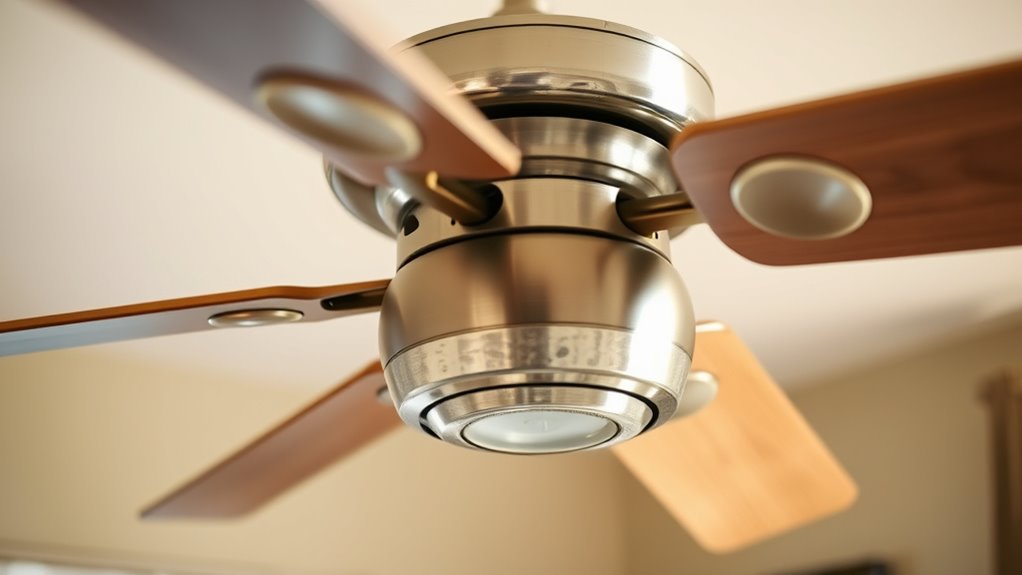
Even with regular cleaning and balancing, there comes a point when your ceiling fan may need replacing. If your fan is over 10 years old and continues to wobble despite proper installation and adjustments, it’s time to evaluate a replacement.
Signs like a slowing ceiling fan motor, unusual buzzing, or squeaking indicate the fan’s components might be worn out or damaged beyond repair. If tightening, cleaning, and balancing no longer fix a wobbly ceiling, the problem likely lies with the motor or other parts that can’t be restored easily.
Upgrading to a modern, properly installed ceiling fan can eliminate wobbling issues and boost energy efficiency. When in doubt, consulting a professional can help determine if repair is enough or if a full replacement is the best choice.
Frequently Asked Questions
How to Stop a Wobbling Ceiling Fan?
If your ceiling fan wobbles, start by checking that all blades are securely attached and not warped.
Use a balancing kit to identify and add weights to the wobbling blade.
Tighten all mounting hardware, including screws and brackets.
Clean dust from the blades and motor to guarantee even weight distribution.
After adjustments, turn on the fan at high speed to see if the wobbling stops.
Is There an Easy Way to Balance a Ceiling Fan?
Imagine your ceiling fan as a delicate dance troupe, each blade a dancer in perfect harmony. To achieve this balance easily, grab a balancing kit with weights and clips.
Attach clips to identify the wobbling blade, then add small weights along its length. This simple act tunes your fan’s performance, preventing wobble and keeping the rhythm smooth.
Regular cleaning and tightening further maintain this graceful, wobble-free dance in your ceiling.
Why Is My Fan Wobbling While Spinning?
Your fan wobbles while spinning because the blades might be unbalanced or warped. This causes uneven airflow and vibrations.
Loose blade screws or mounting hardware can make the blades shift, leading to wobbling.
Dust or debris buildup on the blades or motor can also create imbalance.
Additionally, improper installation or worn-out blades can contribute to the wobbling.
Check these issues and tighten, clean, or replace parts as needed to fix it.
Can a Ceiling Fan Be Rebalanced?
Imagine your ceiling fan as a tightrope walker wobbling on a thin wire. Yes, you can rebalance it! Using a balancing kit, you attach small weights to the blades, fine-tuning its balance.
Identify the wobbly blade with a clip, then adjust the weights to steady the spin. Regular cleaning and tightening hardware help keep your fan smoothly gliding, turning wobble into a distant memory.
Conclusion
A wobbling ceiling fan can indeed be a nagging annoyance, but with these quick fixes, you hold the power to restore peace and comfort in your space. Don’t let imbalance steal your home’s harmony—think of your fan as a trusted partner needing a little care. With each tightening, cleaning, and adjustment, you’re not just fixing a wobble; you’re reclaiming a quiet, steady breeze that makes your home feel truly yours.
